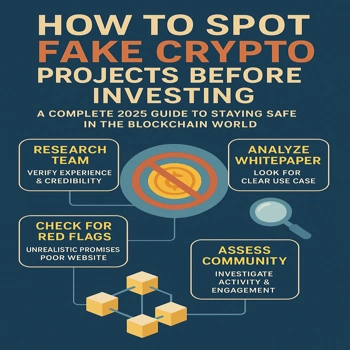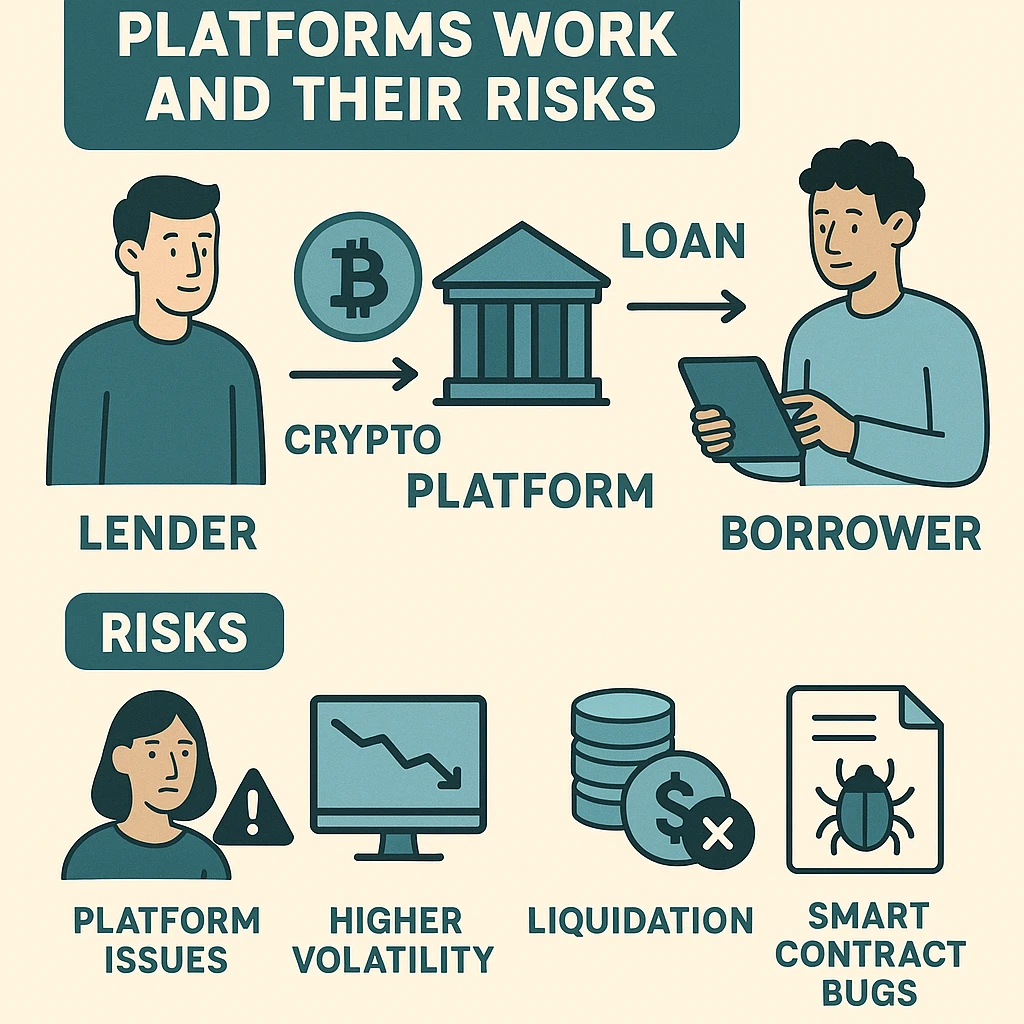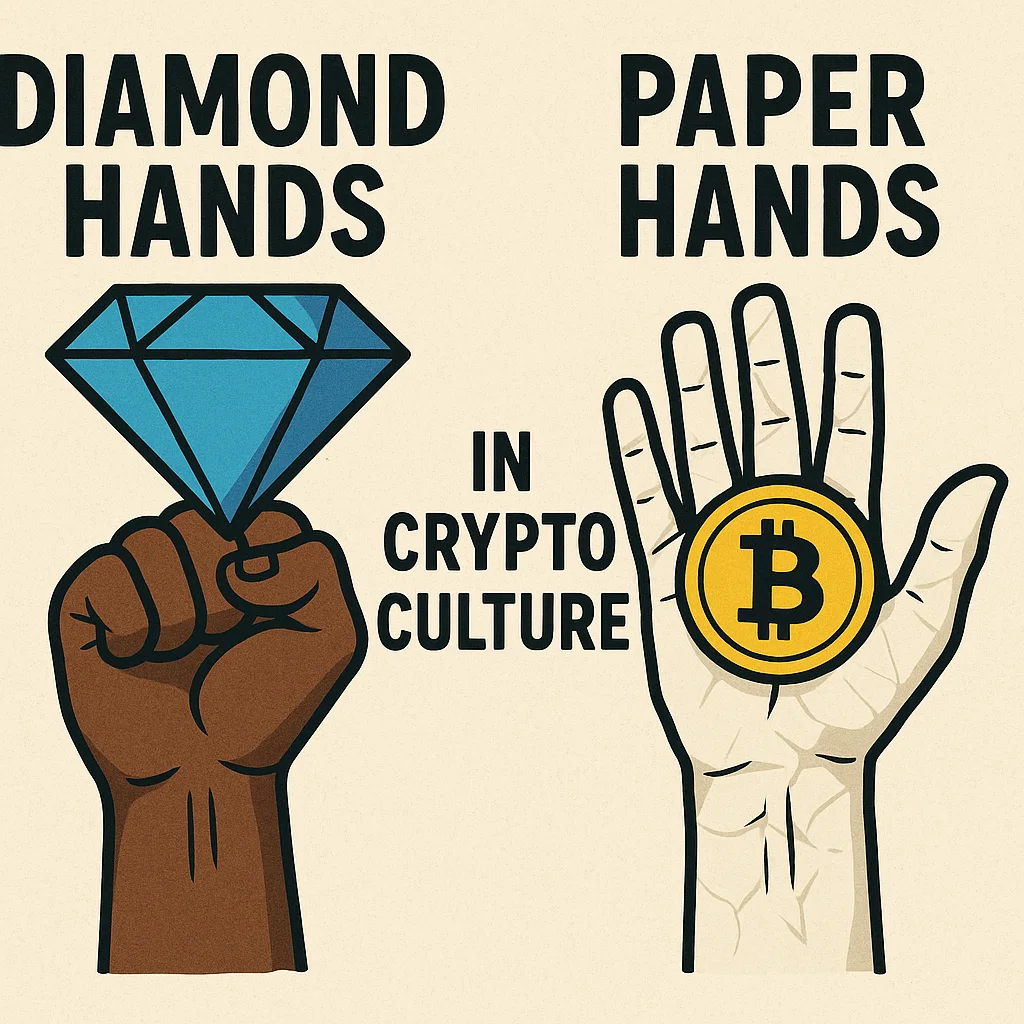Introduction
Over the past ten years, there has been an amazing expansion in the cryptocurrency market. Some investors have lost a lot of money to fraudulent cryptocurrency businesses, but many others have achieved exponential profits. Scammers can readily capitalize on investor hype because there are low barriers to entry when starting a token or decentralized platform.
Differentiating between genuine and fraudulent initiatives is more important than ever in 2025, when the use of cryptocurrencies is at an all-time high. This tutorial will provide you the skills and information you need to see warning signs, comprehend the basics of the project, and stay away from the next major fraud.
1. Understanding the Anatomy of a Fake Crypto Project
Fake cryptocurrency projects frequently resemble real ones in construction but fall apart when examined closely. What most frauds have in common is this:
-
Hyped Whitepapers: Long, jargon-filled texts that say a lot yet explain little.
-
Anonymous Teams: no information about the developers or founders that can be verified.
-
Unrealistic Promises: promises of "guaranteed" returns of 10x to 100x.
-
Copycat Websites and Social Media: elegant websites that imitate well-known platforms.
Instead of creating something real, these phony tokens frequently follow the trends of popular niches like AI, NFTs, or DeFi.
2. Red Flags Every Investor Should Watch For
A. Anonymous or Fake Founding Team
Investigating the project team is one of the simplest methods to spot a scam. It's a warning sign if you can't locate reliable interviews, social media presences, or LinkedIn profiles. Scammers frequently fabricate teams using stock images and phony names.
Tip: Verify credentials and profile images using reverse image search on trustworthy websites like GitHub or LinkedIn.
B. No Clear Use Case
Every genuine cryptocurrency initiative must to have a distinct purpose. It may be a money grab if you are unable to comprehend the purpose of the token or how it addresses a practical issue.
Scammers frequently create hype around nebulous concepts like "revolutionizing finance" without a concrete plan or offering.
C. Locked Liquidity and Smart Contract Audits
A high-risk project is one that doesn't do third-party smart contract audits or lock liquidity. Developers can easily pull a rug and take all of the investor money if liquidity isn't locked.
Seek out audits from reputable companies such as Slowmist, Hacken, or CertiK. Although an audit is a step toward legitimacy, it does not ensure safety.
D. Pumped Marketing With No Substance
Be wary of a new initiative that spends a lot of money on influencer marketing or promoting on Twitter, YouTube, and Telegram but has no whitepaper or actual technology to show for it.
Pump-and-dump groups often use this tactic to draw in FOMO-driven investors.
3. Case Studies of Notorious Fake Projects
BitConnect
BitConnect, arguably the most notorious cryptocurrency fraud ever, promised investors enormous profits through a loan platform supported by an enigmatic "trading bot." In actuality, it was a Ponzi scheme that cost billions of dollars when it crashed in 2018.
OneCoin
OneCoin, dubbed a "Bitcoin killer," raised more than $4 billion worldwide. But the founders disappeared with investor money, and the coin was never published on any market. It is still a story of naive trust.
4. Tools and Techniques to Vet Crypto Projects
A. Whitepaper Analysis
Go over the whitepaper carefully. Does it provide clear explanations of the technological method, market need, application case, and tokenomics? An excellent whitepaper should be clear and simple to read.
Avoid projects with:
-
Excessive buzzwords
-
No real product details
-
Unverified statistics
B. Tokenomics Check
Examine the distribution mechanism, overall supply, and any vesting periods for private or team investors.
Warning Signs:
-
Large portions allocated to team or developers
-
No lockup periods
-
Unlimited minting rights
C. Community Engagement
On sites like Reddit, Discord, or Telegram, genuine initiatives have vibrant and open communities. Pose queries and observe the responses of users and moderators.
A toxic, overly hyped, or tightly controlled community is a red flag.
D. GitHub Repositories
Code for open-source projects is usually stored on GitHub. The absence of a repository or its inactivity may suggest that the developers are not actually creating anything.
Check:
-
Frequency of commits
-
Code quality
-
Community contributions
E. WhoIs & Domain Lookup
Scam websites are frequently put together hastily. Use tools such as WhoIs to verify the registration details and domain age. A recently registered domain with privacy protection ought should raise red flags.
5. The Role of Temporary Email Services in Investigating Projects
Temporary email platforms like 10minutesmails and mytemp-mail are not just useful for privacy — they can be powerful tools for testing a project's transparency.
You can:
-
Sign up for newsletters without giving personal data.
-
Verify how a project handles email marketing and communication.
-
Track shady sign-up practices or spam.
Using disposable emails helps you stay anonymous while evaluating potentially harmful platforms.
6. Psychological Tactics Scammers Use
Scam crypto projects often rely on emotional manipulation:
-
Fear of Missing Out (FOMO): “Get in before it’s too late!”
-
Urgency: “Limited presale slots available now.”
-
Authority Illusion: Fake endorsements from celebrities or "trusted experts."
Being aware of these tactics helps you remain rational and not act on emotion.
7. How Regulatory Bodies Can Help (and Their Limits)
While crypto operates in a decentralized landscape, some protection exists:
-
Check for SEC or FCA warnings about known scams.
-
Use CoinMarketCap or CoinGecko to verify if a token is recognized.
-
Follow reputable news sources like CoinDesk, The Block, or CryptoSlate.
But remember — not every scam gets flagged in time. Your best defense is due diligence.
8. Post-Investment Monitoring and Safety Tips
Even if you’ve invested in what seems to be a legit project, you still need to stay cautious:
-
Use cold wallets to store large amounts of crypto.
-
Avoid giving out private keys or seed phrases.
-
Monitor project updates and community channels for transparency.
9. What to Do If You've Been Scammed
If you fall victim to a fake project:
-
Report the scam to platforms like Chainabuse, CoinMarketCap, and your local cybercrime unit.
-
Warn others on social media and Reddit forums.
-
If funds were sent via centralized exchanges, contact them immediately with wallet addresses and transaction IDs.
10. Pro Tips from Crypto Security Experts
We spoke with several blockchain security professionals, and here are their top insights:
-
“Always assume a project is fake until proven otherwise.” – John B., Smart Contract Auditor
-
“Don’t chase hype. If everyone is talking about it and you’re late, you’re already too late.” – Maria P., DeFi Analyst
-
“Use cold wallets and temp mails like mytemp-mail to reduce identity exposure.” – Andre L., Crypto Educator
Conclusion: Think Before You Click 'Buy'
One of the most exciting yet unstable industries is still cryptocurrency. There is a genuine chance to increase your fortune, but there is also a chance that you could fall victim to scams.
By understanding the signs of a fake project, conducting proper due diligence, and utilizing privacy tools like 10minutesmails and mytemp-mail, you can dramatically reduce your chances of becoming a victim.
Always remember: In crypto, knowledge is your greatest asset.





Leave a Reply